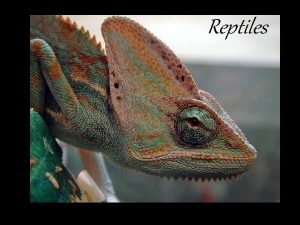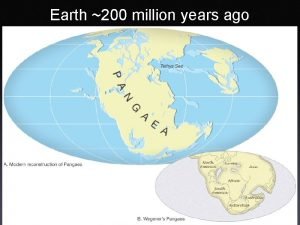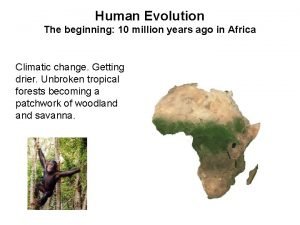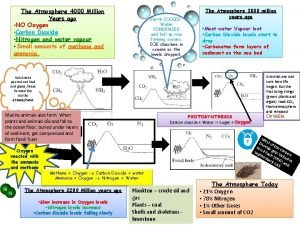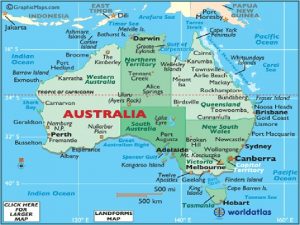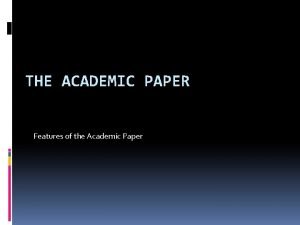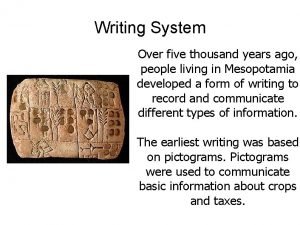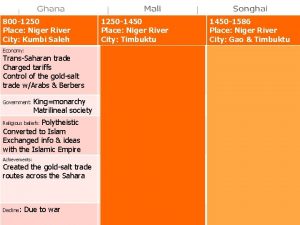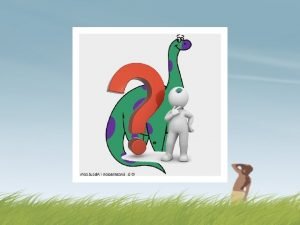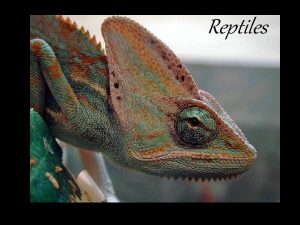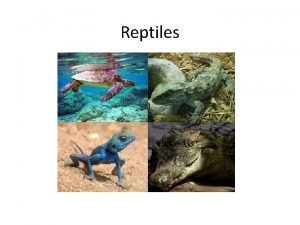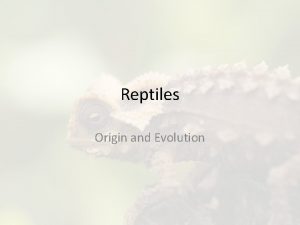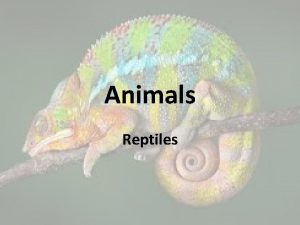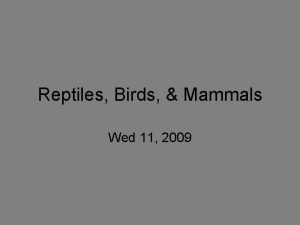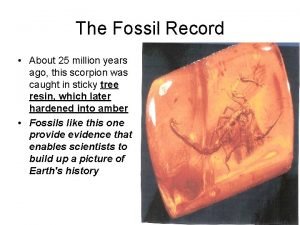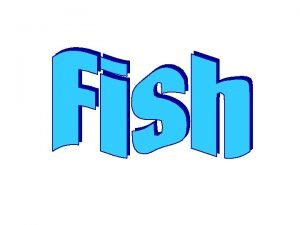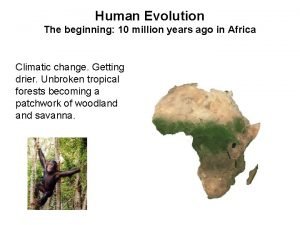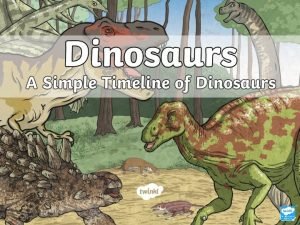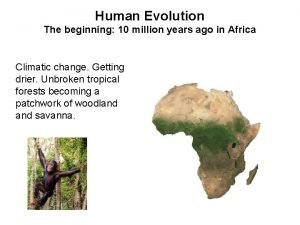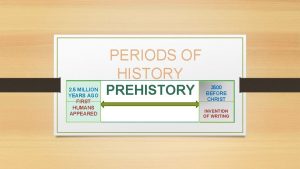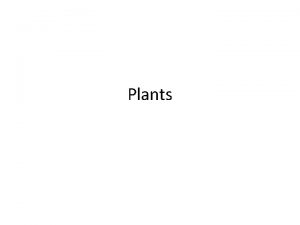Reptiles 310 million years ago reptiles were the



























- Slides: 27

Reptiles

310 million years ago… reptiles were the first vertebrates to make the complete transition to life on land

CHARACTERISTICS OF REPTILES

Amniote Egg • an egg with a protective membrane and a porous shell enclosing the developing embryo. -It forms a “nursery” to protect the embryo - The egg derives its name from the amnion, the thin membrane enclosing the salty fluid in which the embryo floats. • They yolk sac encloses the yolk, a protein rich food supply for the developing embryo • The allantois stores the nitrogenous wastes produced by the embryo until the egg hatches

• The chorion lines the outer shell and thus encloses the embryo and all the other membranes. It regulates the exchange of oxygen and carbon dioxide between the egg and the outside environment. • The entire amniote egg is surrounded by a leathery shell that may be hard in some species because of the presence of calcium carbonate. -The egg is water proof, however it allows gases to flow between the environment and the chorion. • The male places the sperm inside the female before the shell is formed. This is called internal fertilization, makes water transport of sperm unnecessary.

Waterproof Skin • dry body covering of horny scales or plates – develops as surface cells fill w/ keratin - same stuff as bird feathers and fingernails – prevent water loss – protect from wear and tear associated w/ living in rugged terrestrial environments – unlike amphibians who can’t be far from water or they’ll dry out

External Structural Adaptations (for land) • • • some limbs have toes w/ claws – permit to climb, dig, and move in various terrains others have toes modified into suctions cups – aid in climbing absence of limbs – snakes use scaly skin and highly developed skeletal and muscular systems

Respiration • Well developed lungs (not gills) – tissues involved in gas exchange area located A. Respiration inside body - kept moist in even driest environments

Circulation • • like amphibians have double circulation most have 3 chambered heart partial division of ventricle separates oxygen-poor blood flowing from the body from the oxygen-rich blood returning from the lungs alligators and crocodiles have 4 chambered hearts – separation of oxygenated and deoxygenated blood

Excretion • conserve water by excreting nitrogenous wastes in dry or pasty form as crystals of uric acid

Temperature Regulation • • metabolism rate controlled in part by body temperature Ectothermic (cold-blooded) – body temp controlled by environment not endothermic (warm-blooded) regulate their temp by behavior – bask in sun to speed up metabolism – hide in shade to prevent overheating

Modern Reptiles • Reptiles are classified into 16 orders, 12 that are extinct. - 4 surviving-6, 000 species • Reptiles occur worldwide except in coldest regions • 4 living orders of Class Reptilia: - 1. Rhynchocephalia, - 2. Chelonia, - 3. Crocodilia, - 4. Squamata

Rhynchocephalia An order of lizard-like reptiles. Also known as Tuatara. - Inhibit islands of coast of New Zealand - Resembles a large lizard about 60 cm long - Has an inconspicuous third eye on top of its head- parietal eye- functions as a thermostat- protects from overheating - Active at low temperatures and feed at night on insects, worms and small animals

Chelonia • Order consists of about 265 species of turtles and tortoises - Tortoise are terrestrial Chelonia (Galapagos tortoises) - Turtles- chelonians that live in water - Body covered by a shell made of hard plates- 2 parts- a carapace and plastron - Forelimbs of a marine turtle have evolved into flippers and freshwater turtles have webbed toes - Migratory behavior of sea and river turtles -return to land to lay eggs.

Crocodilia • Order composed of 20 species of large lizard-shaped reptiles- crocodiles, alligators, caimans and gavials - Descendants of archosaurs • Crocodilians live in or near water in tropical/ subtropical regions of the world • - Crocodiles- nocturnal animals; Africa, Asia and America • - Alligators - China and southern U. S. - Caimans - Central America- some in Florida - Gavials- eat fish; long and slender snout - live only in Burma and India

Squamata • Order consists of 5, 640 species of lizards and snakes - Structurally diverse • Lizards- presence of limbs • - Common lizards- iguanas, chameleons, skinks and geckos - Live everywhere except Antarctic - Special adaptations- agility and camouflage - 2 species are venomous- Gila monster (SW U. S. ) and beaded lizard (western Mexico) - Most prey on insects or small animals

REPTILES IN THE PHILIPPINES

ASIAN LEAF TURTLE • The Asian leaf turtle (Cyclemys dentata) is a species of turtle found in Southeast Asia. They are quite common in the pet trade. • It is an omnivorous species that will feed upon vegetation, fish, insects, worms, and carrion. • The turtle can be found in North India, Bangladesh, Myanmar (Burma), Thailand, Cambodia, Vietnam, West Malaysia, Indonesia (Sumatra, Java, Borneo, Bali), Philippines (Palawan: Calamian Islands

Philippine forest turtle • • It is classified as critically endangered. It is known as the Philippine forest turtle, the Philippine pond turtle, the Palawan turtle, or the Leyte pond turtle. Despite the latter common name, it does not occur in the island of Leyte but is instead native to the Palawan island group Due to its rarity and its status as newly rediscovered, little is known of the life cycle of the Philippine forest turtle. From observations, however, Philippine forest turtles appear to exhibit long life spans and high adult survival rates. Like most turtles, their sexual maturation is delayed but they are able to mate multiple times before

marbled crested lizard • Marbled crested lizard, marbled bloodsucker or marbled agamid lizard is a species of lizard. It is endemic to the Philippines, where it inhabits lowland dipterocarp and montane forests at elevations 400 to 800 m above mean sea level. • It is typically found on branches and leaves of trees. It feeds on insects and is oviparous, digging the soil to lay its eggs at the base of trees.

flying dragon • • • Draco volans, the common flying dragon, is a species of lizard endemic to S outheast Asia. Like other members of genus Draco, this species is known for its ability to glide using wing-like lateral extensions of skin called patagia. this lizard grows up to 22 centimeters in length, including the tail. The body is tan in color with dark flecks. The patagium of the male is tan to bright orange with dark banding. The female's patagium has irregular markings rather than banding. This species can be found in Indonesia, Thailand, the Philippines, Vietnam, and Singapore.

Northern Sierra Madre forest monitor • The Northern Sierra Madre forest monitor (Varanus bitatawa), also known by the local names bitatawa, baritatawa, and butikaw, is a large, arboreal, frugivorous liza rd of the genus Varanus. The lizard is a staple food of the Aeta and Ilongot indigenou s people of the Philippines. • The known range of Varanus bitatawa is currently limited to the Sierra Madre Forest on the northeastern coast of the island of Luzon, Philippines.

dog-toothed cat snake • • Boiga cynodon, commonly known as the dog-toothed cat snake, is a nocturnal species of snake endemic to Asia. It is a large snake, reaching more than 2 m (6 1⁄2 ft) in total length. The front teeth of the upper jaw and the lower jaw are strongly enlarged. ] The body is slender and laterally compressed. Dorsally it is tannish with reddish-brown or dark brown crossbands. There is a dark streak behind the eye on each side of the head. The venter is whitish, heavily marbled with dark brown. Philippine Islands (Basilan, Culion, Dinagat, Leyt e, Luzon, Mindanao, Palawan, Panay, Polillo, Sibutu, Sulu Archipelago)

Gervais' worm snake • • Calamaria gervaisii, commonly known as Gervais' worm snake, is a relatively small-sized burrowing or fossorial snake in the family Colubridae. Calamaria gervaisii is endemic to the Philippine Islands. Its range includes the islands of Luzon, Polillo, Mindoro, Tabla s, Panay, Negros, Cebu, Catand uanes, Mindanao, Lubang and B asilan and it is found from near sea level up to altitudes of 1, 000 m (3, 281 ft). It lives in forests and plantations, burrowing in the leaf litter and hiding under stones, fallen logs or between the buttresses of

Philippine cobra • • • The Philippine cobra (Naja philippinensis) also called northern Philippine cobra, is a stocky, highly venomous species of spitting cobra native to the northern regions of the Philippines. The Philippine cobra is called ulupong in Tagalog, carasaen in Ilocano and agawason in Cebuano. Bisaya. The Philippine cobra occurs mostly in the northern regions of the Philippines. They can be found on the islands of Luzon, Mindoro, Catanduanes, Azria and Masbate. The Philippine cobra’s habitat include low-lying plains and forested regions, along with open fields, grasslands, dense jungle, agricultural fields, and human settlements. This species of cobra is particularly fond of water, so it can be found very close to

• • Philippine crocodile or Mindoro crocodile The Philippine crocodile is a crocodilian endemic to the Philippines. It is a relatively small, freshwater crocodile. It has a relatively broad snout and thick bony plates on its back (heavy dorsal armor). Females are slightly smaller than males. Philippine crocodiles are golden -brown in color, which darkens as they mature. The Philippine crocodile has been extirpated in Samar, Jolo, Negros, Masbate, and Busuanga. Populations still survive in the Northern Sierra Madre Natural Park within the Luzon rainforest, San Mariano, Isabela, Dalupiri island in the Babuyan Islands, Abra (province) in Luzon and the Ligawasan Marsh, Lake Sebu in South Cotabato, Pulangi River in Bukidnon, and possibly in

 Varanus bitatawa
Varanus bitatawa The earth 200 million years ago
The earth 200 million years ago 10 million years ago
10 million years ago 3800 million years ago
3800 million years ago Earth 4600 million years ago
Earth 4600 million years ago Four score and ten years ago
Four score and ten years ago How many calories are in today’s portion of soda?
How many calories are in today’s portion of soda? On kawara one million years
On kawara one million years Halloween 2000 years ago
Halloween 2000 years ago Two years ago jenny was diagnosed with schizophrenia
Two years ago jenny was diagnosed with schizophrenia Australia 50 000 years ago
Australia 50 000 years ago It is easy to forget how difficult life was 50 years ago.
It is easy to forget how difficult life was 50 years ago. Why did the barley sign change shape?
Why did the barley sign change shape? Dinosaurs lived millions of years ago what did they eat
Dinosaurs lived millions of years ago what did they eat How much is four score and seven years
How much is four score and seven years 125 years ago today
125 years ago today Saturn 4 billion years ago
Saturn 4 billion years ago Shenzhen 30 years ago
Shenzhen 30 years ago Andre courreges biography
Andre courreges biography Technicom 15 years ago as a small
Technicom 15 years ago as a small 4 000 years ago
4 000 years ago Four score and seven years
Four score and seven years Once upon a time there live
Once upon a time there live Africa 1000 years ago
Africa 1000 years ago Eight years ago today
Eight years ago today Family life 100 years ago
Family life 100 years ago Dinosaurs were reptiles that lived
Dinosaurs were reptiles that lived 300 solar years to lunar years
300 solar years to lunar years
